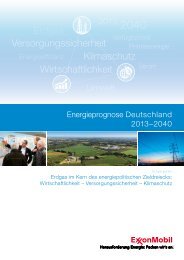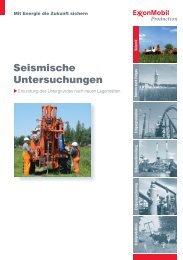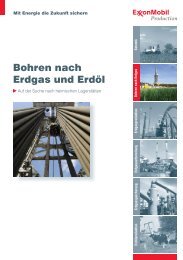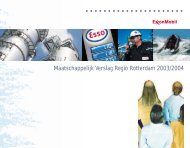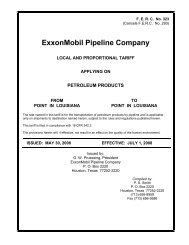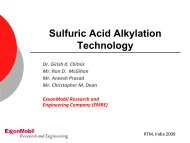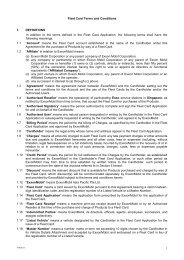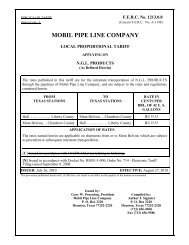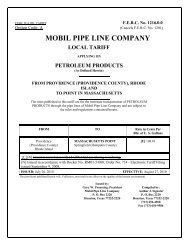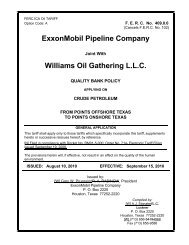The Lamp - ExxonMobil
The Lamp - ExxonMobil
The Lamp - ExxonMobil
You also want an ePaper? Increase the reach of your titles
YUMPU automatically turns print PDFs into web optimized ePapers that Google loves.
Panorama<br />
27<br />
Around the world with <strong>ExxonMobil</strong> Torrance refinery adds massive clean-air facilities<br />
New <strong>ExxonMobil</strong> MasterCard<br />
features unlimited gasoline rebates<br />
<strong>ExxonMobil</strong> and Citi Cards have launched a new <strong>ExxonMobil</strong><br />
MasterCard that offers rebates on gasoline purchased at<br />
U.S. Exxon and Mobil retail locations.<br />
Cardholders<br />
earn rebates of 15<br />
cents per gallon,<br />
and there is no limit<br />
on the amount of<br />
rebates that can be<br />
earned. However,<br />
those opening a<br />
new <strong>ExxonMobil</strong><br />
MasterCard account<br />
during the promotion period that ends December 31, 2008,<br />
will earn rebates of 30 cents per gallon for the first 60 days.<br />
“Most cards offer percentage rebates off the total price,”<br />
says Ben Soraci, <strong>ExxonMobil</strong> U.S. Retail Sales director. “Our<br />
card has the competitive advantage of offering a cents-pergallon<br />
rebate that allows consumers to easily calculate their<br />
savings.”<br />
In addition, <strong>ExxonMobil</strong> MasterCard customers earn<br />
annual rebates of up to 2 percent on the first $10,000 in<br />
other eligible purchases and a 1 percent rebate on other<br />
eligible purchases of more than $10,000.<br />
<strong>The</strong> rebates will be automatically credited on monthly<br />
cardholder statements in $10 increments toward future<br />
Exxon and Mobil gasoline purchases made with the card.<br />
Other card features include:<br />
No annual fee<br />
0 percent APR on purchases, plus no-interest balance<br />
transfers for the first six months<br />
Ability to link to Speedpass<br />
For more information, visit exxonmobilcard.com.<br />
One of the largest single environmental<br />
upgrades in the<br />
79-year history of <strong>ExxonMobil</strong>’s<br />
refinery in Torrance, California, is<br />
nearing completion.<br />
<strong>The</strong> project involves installation<br />
of two electrostatic precipitators<br />
(ESPs) at the refinery’s fluid catalytic-cracking<br />
plant. Estimated<br />
to cost more than $300 million,<br />
the ESPs will put the refinery in<br />
compliance with a new statemandated<br />
clean-air regulation<br />
requiring substantial cuts in<br />
particulate-matter emissions.<br />
About the size of a 12-story<br />
building, each ESP was assembled<br />
at a remote site within the<br />
refinery. <strong>The</strong> project elected to<br />
follow unconventional modular<br />
construction due to facility congestion<br />
around the cat cracker.<br />
“We determined we did<br />
not have adequate space to<br />
safely follow a standard ‘stickbuild’<br />
approach,” says Donald<br />
Runaldue, ESP project executive.<br />
“Instead, we elected to prefabricate<br />
at a safer location inside the<br />
refinery, then lift each module and<br />
transport it to the cat cracker for<br />
installation.”<br />
Rob Sturgis, ESP senior project<br />
manager, adds that the module<br />
approach allowed the project<br />
to install piling, foundations and<br />
structural steel in parallel with ESP<br />
assembly, shortening the construction<br />
span significantly. “This<br />
was particularly helpful since we<br />
were faced with a very tight construction<br />
schedule,” says Sturgis.<br />
Gene Weber, ESP technical<br />
manager, notes the dimensions<br />
of the ESPs and various components<br />
are impressive.<br />
“<strong>The</strong> ESP-1 module weighed<br />
1,200 tons, while the fully<br />
assembled ESP-2 weighed<br />
almost 1,600 tons,” says Weber.<br />
“Fully erected, the completed<br />
units measure 125 feet tall, 174<br />
feet long and 85 feet wide. One<br />
bypass duct has a diameter of<br />
13 feet – wide enough to drive a<br />
car through. Some of the major<br />
valves have diameters of 11 feet<br />
or more.”<br />
Startup is planned for January<br />
2009.<br />
<strong>The</strong> huge ESP-1 (above and left) shown being moved to its<br />
installation site inside the Torrance Refinery stood 12 stories<br />
tall and had a transport weight of 1,200 tons.




